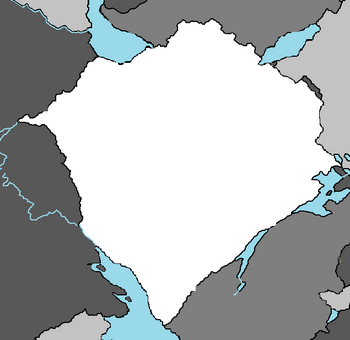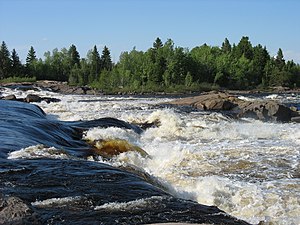Mayotte
Republic of Mayotte | |
|---|---|
|
Flag | |
 | |
| Capital | Bettencourt |
| Largest city | Blythe |
| Official languages | Caticeze-English, Avergnonian, Drambenburgian |
| Demonym(s) | Mayottean |
| Government | Republic |
| Thomas Bonhomme | |
| Establishment | |
• Kingdom of Mayotte | 1125 |
• Province of Zamastan | July 6th, 1882 |
• Independence | January 1st, 2021 |
| Population | |
• 2020 estimate | 27,132,000 |
| Date format | mm-dd-yyyy |
The Republic of Mayotte, most commonly known as Mayotte, is a nation in the Coalition of Crown Albatross located on the continent of Euronia, bordered by Zamastan, Avergnon, Muprueburg, East Chanchajilla, Zastaland, and Auraine, with a small coastline on the Cantalle Ocean. It was formally a province of Zamastan (also called Mayotte), but gained independence alongside Auraine and Alutiana on January 1st, 2021 following the Bettencourt Protests and the Supreme Court ruling in Bettencourt v. Government of Zamastan.
The history of Mayotte spans thousands of years, with much of the Fifty Years War between the Drambenburgian kingdoms and the Palatinate of Aunistria in the 1300s, the Parabocan War in the late 1800s, and sections of the World War being fought in this province. While being a administrative region of Zamastan since the 1880s, Mayotte long harbored nationalist and separatist sentiment, largely wishing independence or greater autonomy from the federal government. The election of President Atticus Moreau, a member of the Bloc Mayotte Party, in 2020 boosted the hopes for independence, while the Bettencourt Protests further drove those inspirations. Thomas Bonhomme, previously the governor of the province who had instigated the independence referendums, was elected President of Mayotte.
Bettencourt is the capital of Mayotte, and Blythe is the largest city. Other major cities include Antirault, Ballycommon, Bourgueux, Strallingen, Westven, and Lomheuvel. Roughly 30% of the country's population are direct descendants of first or second generation immigrants, mostly Avergnonian, Drambenburg, East Chanchajilla, and Shoassauan. The country has a highly diversified economy, with major sectors including transportation, education, information technology and research, government services, and mining and a major tourist destination for outdoor recreation. Much of the population speaks Avergnonian or Drambenburgian.
History
Prehistory
Antiquity
Middle Ages
Modern Era
21st Century
Geography
Located east of Zamastan, and (from a historical and political perspective) part of Central Euronia, Mayotte occupies a large territory, most of which is very sparsely populated. Its topography is very different from one region to another due to the varying composition of the ground, the climate (latitude and altitude), and the proximity to water. The Lawrence Lowland and the Louise Mountains are the two main topographic regions in western Mayotte, while the Aunistria Shield occupies most of central and eastern Mayotte.
Hydrography
Mayotte has one of the world's largest reserves of fresh water, occupying 12% of its surface. It has 3% of the world's renewable fresh water, whereas it has only 0.3% of its population. More than half a million lakes, including 30 with an area greater than 250 square kilometres (97 sq mi), and 4,500 rivers pour their torrents into the Toyana Ocean, through the Bay of Titania. The largest inland body of water is Lake Louise, although it is bordered and shared by East Chanchajilla, West Chanchajilla, and Gladysynthia. That makes Caniapiscau Lake, created in the realization of the Titania Bay Project to produce hydroelectric power, the largest inland body of water located entirely in the country. Lake Sistassini is the largest natural lake in Mayotte
The Jacquinot River has some of the world's largest sustaining inland Toyana Ocean ports at Livenneau and Pergrinau. Its access to the Toyana Ocean and the interior of Euronia a strategic place for the middle ages kingdoms and Drambenburgian Empire and made it the base of early exploration and settlement in the 17th and 18th centuries. The river broadens into the world's largest estuary, the feeding site of numerous species of whales, fish, and seabirds. The river empties into the Bay of Titania. This marine environment sustains fisheries and smaller ports in the Lower Jacquinot and Gaspésie regions of the province. The Jacquinot River with its estuary forms the basis of Mayotte's development through the centuries.
Topography
Climate
Wildlife
Demographics
Religion
Languages
Ethnicity
Cities
Politics
Prior to secession, the Governor acted as the province's head of state and runs the legislature of the province. Until 1988, the Mayotte legislature was bicameral, consisting of the Legislative Council and the Legislative Assembly. In that year, the Legislative Council was abolished and the Legislative Assembly was renamed the National Assembly. Mayotte was the last province to abolish its legislative council. Since independence, the President of Mayotte acts as the head of state. The current President is Thomas Braitwhite.
Government
Foreign Relations
Mayotte is a member of the Coalition of Crown Albatross, the Coalition Trade Organization, and is an observer state for the C21. It joined the Independent Coalition of Nations in March of 2021, but left in June of that same year because of disagreements surrounding the Birat Civil War. Its closest ally is Zamastan, its former home-state, which it still holds close connection to through politics, economic, and cultural ties.



